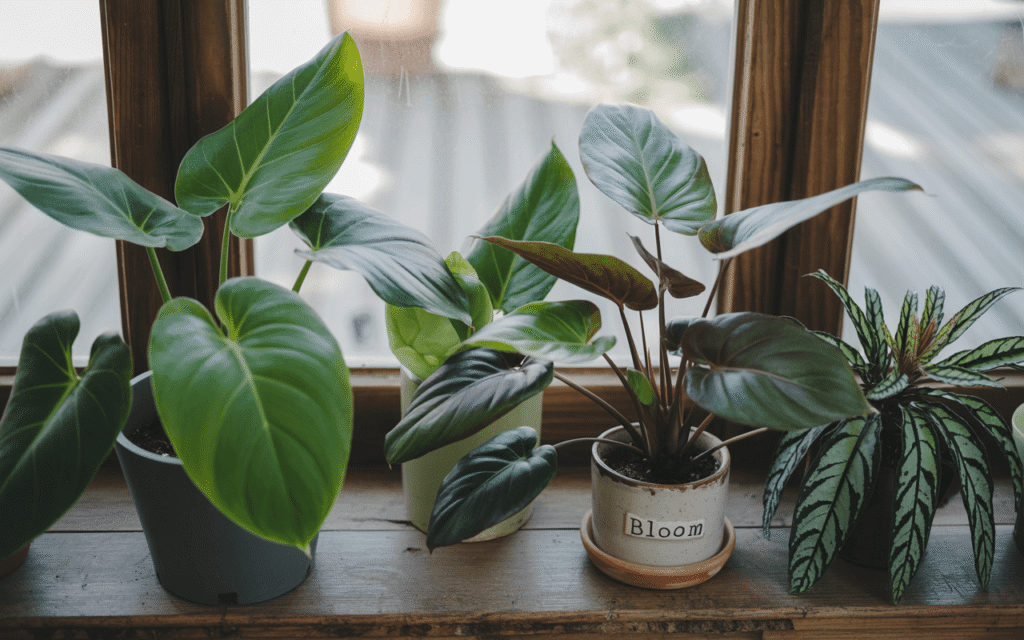Imagine walking into a room where lush, oversized leaves create a sense of calm, beauty, and tropical charm. Indoor plants with big leaves are not just decorative—they’re statement makers. From the iconic Monstera deliciosa with its dramatic split leaves to the elegant Fiddle Leaf Fig, these plants can instantly elevate your home décor.
But big-leaf indoor plants aren’t just about looks. Their wide foliage helps purify the air, boost humidity, and even reduce stress levels. Whether you’re a beginner plant parent or an experienced gardener, large-leaf plants are rewarding, bold, and surprisingly easier to care for than you might think.
In this guide, we’ll explore the best indoor plants with big leaves, care tips, benefits, and styling ideas so you can create your very own indoor jungle.
Why Choose Indoor Plants with Big Leaves?
1. Aesthetic Appeal
Large leaves instantly catch the eye. They act as natural décor pieces, adding texture and depth to your living room, bedroom, or office.
2. Air Purification
Plants with big leaves often have a greater surface area, making them efficient at filtering toxins and improving air quality.
3. Humidity Boosters
These plants release moisture into the air, creating a healthier indoor environment—especially useful in dry climates.
4. Low Maintenance Options
Many large-leaf plants are hardy and adaptable, perfect for both beginners and seasoned plant lovers.
Best Indoor Plants with Big Leaves
1. Monstera Deliciosa (Swiss Cheese Plant)
- Why it’s popular: Known for its iconic split leaves and fast growth.
- Care tips: Thrives in bright, indirect light; water when soil is dry 1–2 inches down.
- Styling idea: Place in a decorative pot to serve as a focal point in your living room.
2. Fiddle Leaf Fig (Ficus lyrata)
- Why it’s popular: Stunning violin-shaped leaves that add elegance.
- Care tips: Needs bright, filtered light and consistent watering. Rotate for even growth.
- Styling idea: Ideal for corners and open spaces due to its upright growth.
3. Elephant Ear Plant (Alocasia & Colocasia)
- Why it’s popular: Giant, heart-shaped leaves that resemble elephant ears.
- Care tips: Prefers humidity, indirect light, and well-draining soil.
- Styling idea: Perfect for creating a tropical vibe indoors.
4. Bird of Paradise (Strelitzia reginae)
- Why it’s popular: Banana-like leaves with the potential to produce exotic flowers.
- Care tips: Loves bright light and regular watering.
- Styling idea: Works beautifully in tall planters in sunny rooms.
5. Calathea Orbifolia
- Why it’s popular: Large, round leaves with silver-green stripes.
- Care tips: Enjoys medium to low light and high humidity. Keep soil slightly moist.
- Styling idea: Great for bedrooms or offices for a calming effect.
6. Rubber Plant (Ficus elastica)
- Why it’s popular: Thick, glossy leaves that grow impressively large indoors.
- Care tips: Prefers bright light and infrequent watering.
- Styling idea: Adds a modern, minimalist look when placed in sleek planters.
7. Philodendron Xanadu
- Why it’s popular: Wide, lobed leaves with a tropical charm.
- Care tips: Thrives in medium light and requires moderate watering.
- Styling idea: Works well as a tabletop or floor plant.
8. Banana Plant (Musa species)
- Why it’s popular: Huge, lush leaves that grow quickly indoors.
- Care tips: Needs lots of sunlight, frequent watering, and high humidity.
- Styling idea: Perfect for sunny corners or near large windows.
9. Dumb Cane (Dieffenbachia)
- Why it’s popular: Large patterned leaves with green, cream, and yellow tones.
- Care tips: Thrives in moderate light and moist soil.
- Styling idea: Adds a splash of color to living rooms or hallways.
10. Peace Lily (Spathiphyllum)
- Why it’s popular: Large glossy leaves and occasional white flowers.
- Care tips: Grows well in low to medium light; keep soil consistently moist.
- Styling idea: Great for low-light spaces like bedrooms or offices.
How to Care for Indoor Plants with Big Leaves
Light Requirements
- Bright, indirect light is ideal for most big-leaf plants.
- Avoid harsh direct sunlight as it can scorch leaves.
Watering Routine
- Water deeply but infrequently.
- Check soil moisture before watering—overwatering is a common mistake.
Humidity Needs
- Many big-leaf plants (like alocasia and banana plants) love humidity.
- Use a humidifier, pebble tray, or mist leaves occasionally.
Fertilizing for Healthy Growth
- Feed with a balanced liquid fertilizer every 4–6 weeks during spring and summer.
- Reduce feeding in fall and winter when growth slows.
Leaf Cleaning
- Dust can accumulate on large leaves, blocking light.
- Wipe with a damp cloth regularly to keep leaves shiny and healthy.
Styling Ideas: Decorating with Big-Leaf Plants
- Statement Corners – Place tall plants like Monstera or Bird of Paradise in empty corners.
- Minimalist Décor – A Rubber Plant in a sleek white pot adds a modern touch.
- Indoor Jungle – Mix various big-leaf plants together for a tropical vibe.
- Bedroom Calm – Use calming plants like Calathea Orbifolia for a serene atmosphere.
- Work from Home Boost – Large-leaf plants reduce stress and improve focus in home offices.
Benefits of Indoor Plants with Big Leaves
- Air purification: Removes toxins such as formaldehyde and benzene.
- Stress relief: Large greenery creates a soothing, relaxing environment.
- Improved focus: Plants in workspaces boost productivity and concentration.
- Interior design: Adds instant sophistication and a tropical vibe.
- Natural humidifiers: Release moisture into the air, improving indoor climate.
Step-by-Step Guide to Growing Big-Leaf Plants Indoors
- Choose your plant – Start with easy-care options like Monstera or Rubber Plant.
- Pick the right pot – Ensure good drainage to avoid root rot.
- Match plant to light – Place light-loving plants near windows, shade-tolerant ones further inside.
- Create a watering schedule – Stick to consistent routines based on each plant’s needs.
- Maintain humidity – Especially for tropical big-leaf plants.
- Prune when necessary – Trim damaged leaves to promote healthier growth.
- Repot as needed – Larger plants may need repotting every 1–2 years.
Common Problems and Solutions
- Yellow leaves: Often caused by overwatering.
- Brown leaf edges: Low humidity or inconsistent watering.
- Drooping leaves: Too little light or dry soil.
- Slow growth: Lack of nutrients—consider fertilizing.
FAQs About Indoor Plants with Big Leaves
1. What is the easiest big-leaf indoor plant to grow?
Monstera deliciosa and Rubber Plants are among the easiest to grow and maintain indoors.
2. Can big-leaf plants survive in low light?
Some, like Peace Lily and Dumb Cane, tolerate low light, but most prefer bright, indirect light.
3. How do I keep my plant’s big leaves shiny?
Wipe them with a damp cloth or use a natural leaf shine spray. Avoid harsh chemicals.
4. Are big-leaf plants safe for pets?
Some are toxic (like Dieffenbachia and Fiddle Leaf Fig). Always check plant safety before bringing them home.
5. How fast do big-leaf indoor plants grow?
It depends on the species. Banana Plants and Monsteras grow quickly, while Fiddle Leaf Figs grow more slowly.
Conclusion
Indoor plants with big leaves are more than just greenery—they’re living pieces of art. They bring nature’s drama into your home, purify the air, boost mood, and transform dull spaces into vibrant sanctuaries. Whether you choose the classic Fiddle Leaf Fig, the tropical Bird of Paradise, or the easygoing Rubber Plant, you’ll enjoy both beauty and health benefits.
🌿 Ready to create your own indoor jungle? Explore more plant guides, care tips, and design inspiration at Green Plant Zone and start your big-leaf plant journey today!

Hi, I’m the creator of Green Plant Zone, a space dedicated to plant lovers. I share tips on indoor and outdoor gardening, plant care guides, and eco-friendly living. My mission is to help you grow healthier, happier plants and bring more greenery into everyday life.
